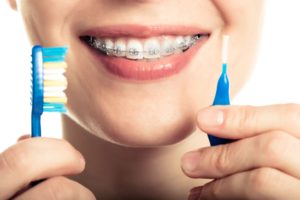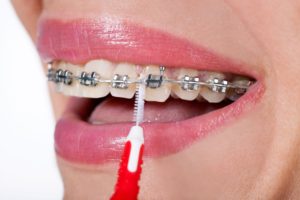Brushing and Flossing with Braces
Management of what may appear as bad teeth in a child is critical to any parent or caregiver. Teenagers are very self-conscious on issues pertaining to their physical look. It is such reasons that warrant the use of interceptive orthodontics. Children around six to eight years have their jaws still growing. It makes it possible to take care of conditions such as teeth crowding, at this early stage. One such orthodontic treatment is the use of braces. Braces are functional in aligning jaws among other issues. Just as the physical look is important, so is the oral hygiene when it comes to people with braces. Brushing teeth and flossing with braces requires a little more attention than usual.

What to consider
When teeth are crooked and crowded, efficient cleaning is nearly impossible as one cannot reach some parts. Accumulation of plaque can lead to gum infection and formation of the hardened plaque on the teeth. Braces straighten the teeth to take care of the problem, but pose another danger. They provide extra places for food to accumulate. Brushing with braces requires the use of a specialized toothbrush head to reach the particles without damaging the braces.
Teeth sensitivity increases with the use of braces for some people. It may not necessarily be as a result of the braces, but more to do with the cleaning mechanisms. Standard electric toothbrushes oscillate at a speed too fast for someone with braces. A specialized electrical brush is regulated to a speed that does not injure the gum line around the brackets and wires.


Brushing teeth with braces
Brushing with braces requires more technique than the natural brushing. We at Advanced Orthodontics Studio encourage people to use the following cleaning steps when cleaning teeth with braces.
- Begin by rinsing out the mouth with water. The water helps loosen any food particles stuck between the braces. A mild mouthwash can be used to make the process more efficient.
- Brush first at the gum line at an angle. Place the brush on top of the brackets and move in motions facing down to clean each bracket.
- Face the brush upwards to clean under the brackets and the wire. Do not move very fast to avoid injuring the gum line and damaging the braces.
- Focus on cleaning each tooth at the gum line, and also above and below each bracket to reach places where plaque accumulates.
- For younger kids, it is advisable for an adult to supervise the cleaning so as to show them how to angle the toothbrush around the brackets. With time they learn how to brush their teeth with braces on their own.
- For people with braces, brushing teeth after every meal or snack is vital. The braces increase the chances of plaque accumulation. In places where it is not possible to brush, rinse out the mouth with water or mouthwash.
- Braces cause the wearing out of a toothbrush faster than usual. It, therefore, requires the change of toothbrush heads regularly to ensure they remain effective in cleaning the teeth and braces.
- Always use toothpaste with fluorine or a mouth wash that is fluorinated. The element helps to prevent the formation of white spots on the teeth and tooth decay.
- Dental checkups such as those offered in our clinics ensure teeth remain healthy and braces are intact and efficient during the orthodontic treatment.
Flossing with Braces
Cleaning out the food debris between the teeth may not be possible with a toothbrush. It requires the special attention of flossing for everyone; with or without braces. Flossing with braces can prove to be quite the task. Most times the floss string gets entangled in the brackets and wires. Entangling it can be painful if not done carefully.
Use an orthodontic floss threader for flossing with braces. It will enable you to floss in between each bracket and wire. The disposable floss is very useful. It is placed in a manner that allows one to pull the floss between teeth, above the wire to reach the gum line.
Children in most case have braces but cannot effectively floss. They may even cause injury to themselves or damage the braces. Parents should be willing to help their children floss. It may take longer since some kids are not patient when it comes to such an activity.
Ensure the use of waxed flossing for people with braces. Non-waxed floss in most cases gets caught on the braces and leaves shreds of the floss between the brackets. Gently pull the floss up to the gum line before removing it to ensure the removal of plaque.
Carry floss with you to eliminate any food that gets stuck between the teeth or brackets. The feeling of food such as meat lodged in between the teeth can be very uncomfortable. Children will especially fuss about it. Having floss will only make it easy for you to handle such a situation.
Always look up in the mirror to see if there are any remaining food particles on the braces. In the case of damage to the braces or injury to the gum while cleaning, visit an orthodontist for repair and treatment.
